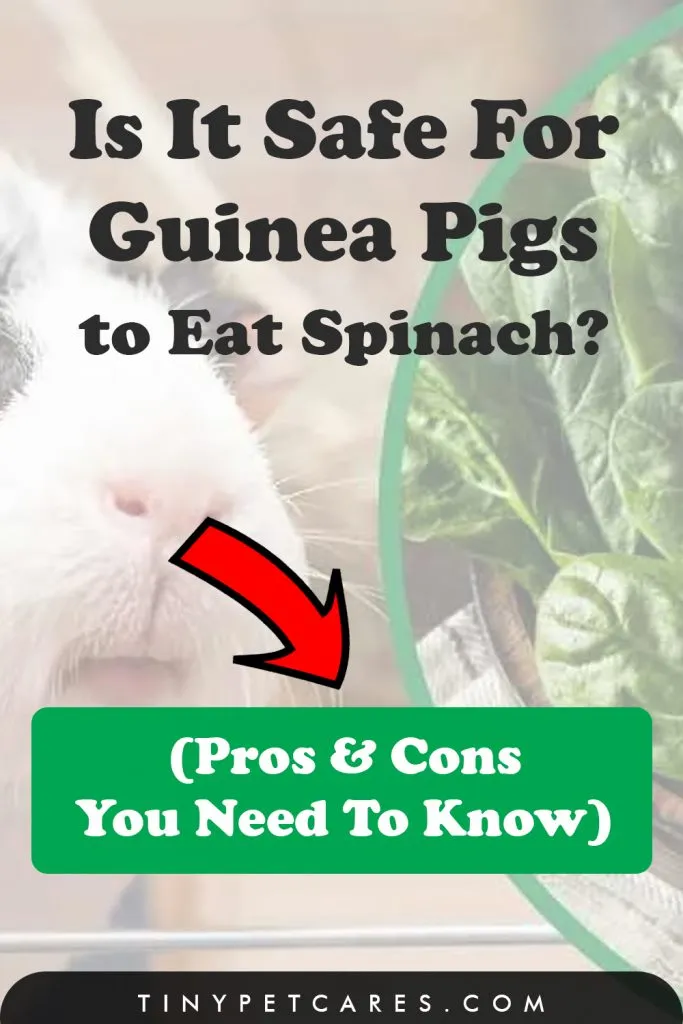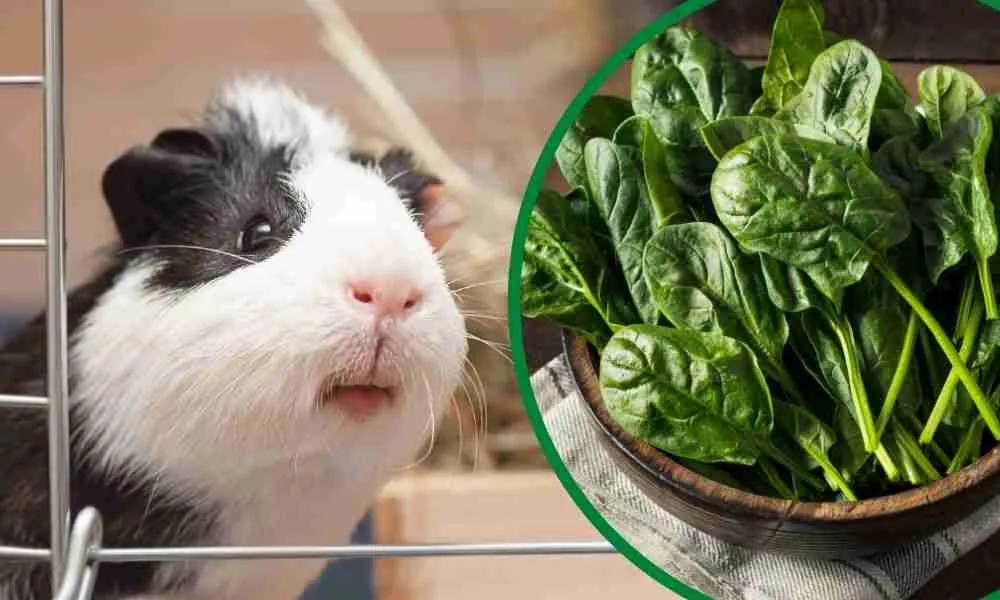Spinach is a leafy green vegetable rich in iron, vitamins, and minerals. It is not only loved by humans but squirrels and rabbits too.
However, you must be wondering, can guinea pigs eat raw spinach?
Yes, guinea pigs can eat raw spinach. Raw spinach has many health benefits for guinea pigs.
However, you should avoid serving spinach to your guinea pigs daily as it contains high amounts of oxalates. Ideally, you should serve small quantities of spinach to your cavies twice or thrice a week.
Now that you have got your answer that guinea pigs can consume spinach, you might have other questions in mind.
Can you serve the whole spinach to your little piggies? Are different parts of spinach such as leaves, stems, stalks safe for guinea pigs?
To get your answers to these questions and many other interesting facts about feeding spinach to guinea pigs continue reading this blog.
Table of Contents
Can Guinea Pigs Eat the Whole Spinach?
The short answer is no. Guinea pigs cannot eat the whole spinach.
You should only feed some parts of spinach to your guinea pigs as occasional treats and to complete their balanced-diet requirement. You might be curious to know what all parts of spinach are safe for guinea pigs.
Let’s find out!
Can Guinea Pigs Eat Spinach Leaves?
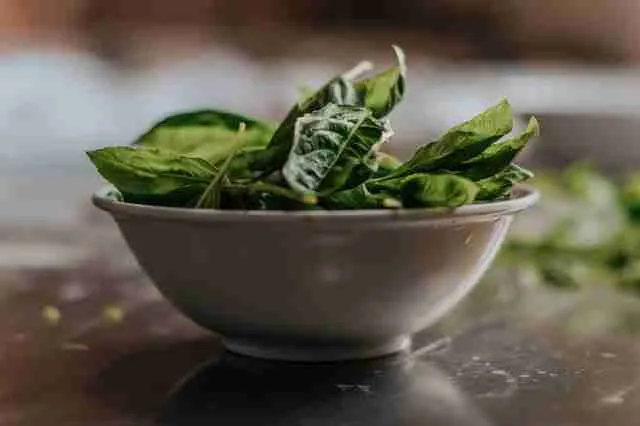
Yes, guinea pigs love eating spinach leaves and they are safe for them too.
You should feed small spinach leaves or leaves of baby spinach to your guinea pigs once or twice a week in small amounts.
Guinea pigs get all important nutrients like Vitamin A, Vitamin C, and minerals like calcium, phosphorus, and iron from spinach leaves.
Can Guinea Pigs Eat Spinach Stems?
No, you cannot feed spinach stems to your guinea pigs. It’s difficult for guinea pigs to chew spinach stems because they are stringy and hard.
As guinea pigs have delicate digestive systems, it’s better to remove stems before feeding spinach to guinea pigs.
Can Guinea Pigs Eat Spinach Stalks?
No, you shouldn’t serve spinach stalks to your cavies.
Just like humans include only spinach leaves in their salads, it’s advisable to not feed stalks to your piggies. Spinach stalks can choke guinea pigs as they are hard to swallow.
Can Guinea Pigs Eat Spinach Seeds?
No, it is not recommended to feed spinach seeds to your guinea pigs. Guinea pigs love leafy vegetables that can be chewed.
Moreover, spinach seeds can get stuck in your cavies’ throats and can cause choking hazards.
Can Spinach Kill a Guinea Pig?
Rest assured, spinach cannot kill your guinea pigs. Spinach is good for the overall health of a guinea pig if you take care of the quantity.
Feeding large amounts of spinach or including it in the everyday diet of a guinea pig, although, can cause many health risks.
If you are curious to know the major health benefits and risks of spinach for guinea pigs, continue reading.
7 Health Benefits of Spinach for Guinea Pigs
There are many health benefits of spinach for guinea pigs. Let’s have a look at them one by one.
Improves Digestive Health:
Spinach is rich in fiber and water content. Both fiber and good water intake are important to maintain good digestive health.
Spinach reduces the chances of constipation and promotes a healthy digestive tract in guinea pigs.
Improves Eyesight:
Spinach is good for guinea pigs’ vision. With age, the eye muscles of guinea pigs start degenerating.
However, if they are fed small amounts of spinach, their eyesight can be prevented from getting damaged.
Spinach is a high source of carotenoids including lutein, beta carotene, and zeaxanthin. All these antioxidants are good for guinea pigs’ eyes and promote a healthy vision.
Promotes Good Cardiovascular Health:
Spinach is a low-calorie diet for guinea pigs. Its low fat and sugar contents help to keep blood cholesterol levels balanced, thereby promoting good cardiovascular health and blood flow.
The antioxidants present in spinach also help in proper blood flow to different body organs of guinea pigs.
Maintains Weight and Removes Toxins:
Since spinach is low in fats and rich in water, it helps to maintain the weight of guinea pigs. Also, the high water content in spinach helps in flushing out the toxins from their bodies.
Prevents Diseases Like Scurvy and Anaemia:
Scurvy is a common disease in guinea pigs. Scurvy is caused by the lack of Vitamin C in guinea pigs’ diet.
Since guinea pigs cannot produce their own Vitamin C, it’s important to provide them with external sources of Vitamin C to make up for the loss.
Therefore, spinach helps prevent scurvy as it is rich in Vitamin C.
Spinach also prevents guinea pigs from getting anemia. Lack of iron in the blood is the cause of anemia or reduced red blood cells and hemoglobin.
Since spinach is a good source of iron, the chances of anemia are less in your cavies if they are served spinach. As a result, they will feel more energetic.
Good for Bones and Teeth:
It is likely for guinea pigs to suffer from weak bones and teeth as they age.
Nonetheless, the rich calcium content of spinach helps in improving the bone density of guinea pigs, besides giving them strong teeth.
Anti-Inflammatory Properties:
As we have seen, spinach is rich in antioxidants. Consuming leafy vegetables having a high content of antioxidants helps to cure inflammation.
Is There a Risk in Feeding Your Cavies Spinach?
Feeding spinach in large amounts to your guinea pigs can cause major health problems. Let’s have a look at some of the health risks of spinach in guinea pigs.
Bladder Stone:
High calcium content in spinach is both an advantage and a disadvantage. Guinea pigs are capable of absorbing more calcium as compared to other animals.
Therefore, if guinea pigs are served large amounts of spinach frequently, there will be high calcium retention leading to the formation of bladder stones.
Bladder stones are extremely painful. Your cavies can experience unbearable stomach pains and difficulty in passing urine.
In most cases, only surgical treatment can help remove bladder stones.
Indigestion:
Since spinach is a good source of fiber, it can cause gastric and indigestion issues in guinea pigs.
Serving more than the recommended quantity can cause diarrhea or watery stool in guinea pigs. Therefore, fibrous veggies should be served in limited quantities to your piggies.
Bloating:
Overdoing spinach in your guinea pigs’ diet can cause stomach ache and bloating since spinach is rich in water.
You would be surprised to know that 100 gms of spinach has around 90 gms of water, which is a lot to cause bloating.
What is the Right Serving Size of Spinach?
It’s important to know the right serving size of spinach for guinea pigs in order to prevent health risks.
Read further if you are curious to know the right serving amount of spinach for guinea pigs.
Can Guinea Pigs Eat Spinach Every Day?
A big NO! Don’t think about feeding spinach to your cavies every day.
Feeding more than the recommended amount can result in several health problems in guinea pigs. Therefore, you shouldn’t include spinach in the everyday diet of your piggies.
How Many Times a Week Can Guinea Pigs Eat Spinach?
Ideally, you should feed finely chopped spinach leaves to your cavies once or twice a week. Some people also feed spinach to their piggies twice or thrice a week but the quantity is very less.
Take Note: It’s best to serve one or two leaves of baby spinach to your guinea pigs once or twice a week. Don’t boil the leaves as it can result in the loss of nutrients. Always serve raw spinach to your cute pets.
How To Prepare Spinach For Guinea Pigs?
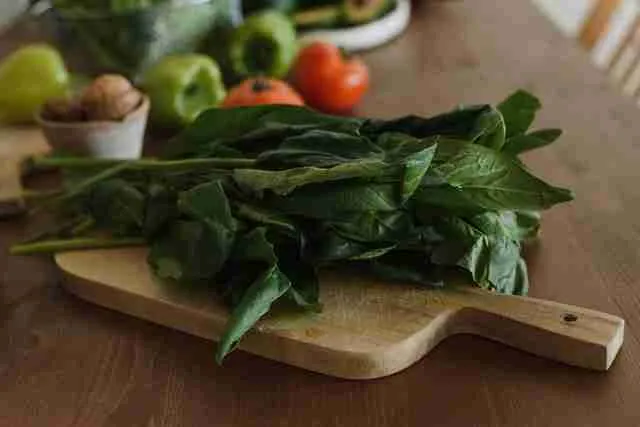
You should be careful while preparing spinach for guinea pigs. Preparing spinach for guinea pigs involves certain steps.
If you are wondering how you can prepare spinach for your cavies, have a look at the following steps.
Step 1: Buying Fresh Spinach
The first step is to buy fresh spinach from a grocery or an organic store. Avoid buying spinach that has yellow leaves or leaves with holes. Ensure that spinach looks green and fresh.
Step 2: Washing Spinach Thoroughly
The next step is to wash the spinach you bought thoroughly under running tap water.
Put spinach in a bowl or a big container and place it under tap water so that dirt and other impurities get washed away.
Washing spinach or any other vegetable also eliminates pesticides and other chemicals.
Step 3: Draining Excess Water
Once you are done washing your spinach, it’s time to transfer it to a drainer to remove excess water.
Excess water can spoil spinach leaves, and hence, it’s important that you don’t forget to drain spinach using a drainer.
Step 4: Removing Stems and Stalks
The next step is to remove stems and stalks. The stems and stalks of spinach should not be fed to your guinea pigs. Therefore, you need to separate the leaves and throw away stems and stalks.
Step 5: Storing Spinach Leaves In a Refrigerator
It’s better to store spinach leaves in a refrigerator if you are planning to feed them at a later time to your piggies.
You can also store extra spinach in the refrigerator after you keep aside 2 or 3 leaves.
Step 6: Chopping the Leaves
Now it’s time to chop the leaves that you did keep aside for your piggies.
Make sure you chop the leaves into small bite-sized pieces before you feed them to your tiny pets. Once chopped, you are ready to serve spinach to your cavies.
Step 7: Cleaning the Area Once Guinea Pigs Finish Eating
The last step is to clean the area once your guinea pig finishes eating. Leaving the area unclean can result in the breeding of germs.
Pro Tip: Since spinach is rich in calcium, it’s better to mix chopped spinach leaves with cucumber, lettuce, and other veggies that are low in calcium.
Can You Feed Your Guinea Pigs Other Types of Spinach?
Yes, there are different types of spinach that you can feed to your guinea pigs.
If you are wondering what all varieties of spinach you can serve your guinea pigs, look at the list below.
Malabar Spinach:
Yes, Chinese Red Spinach or Malabar Spinach is safe for guinea pigs if served in extremely small amounts already as it is rich in calcium and potassium.
Savoy or Semi-Savoy:
Yes, you can feed savoy or semi-savoy spinach to your pigs. Mixing small amounts of spinach and savoy will make spinach crispier and crunchier for your pigs and they will enjoy munching on it.
Smooth-leaf Spinach:
Yes, you can serve smooth-leaf spinach to your guinea pigs in small amounts. However, guinea pigs enjoy veggies with a crispy texture more.
New Zealand Spinach:
Yes, you can feed New Zealand Spinach to your cavies. New Zealand Spinach or Teragonia has the same nutrients as regular spinach.
The only difference is that it needs different weather conditions to grow.
What Are Other Alternatives for Spinach?
You can have a look at the table below to know some alternatives to spinach for guinea pigs.
| Cucumber | Kale | Carrots | Celery |
| Basil | Cauliflower | Broccoli | Asparagus |
| Green Beans | Tomatoes | Dandelions | Green Turnips |
| Bell Peppers | Zucchini | Corn | Savoy |
Related Questions:
Can Guinea Pigs Eat Water Spinach?
No, guinea pigs cannot eat water spinach. Spinach already has high water content.
Therefore, it’s important to avoid giving water spinach to guinea pigs to avoid bloating. Excess water can result in gastric issues too.
Can Guinea Pigs Eat Frozen Spinach?
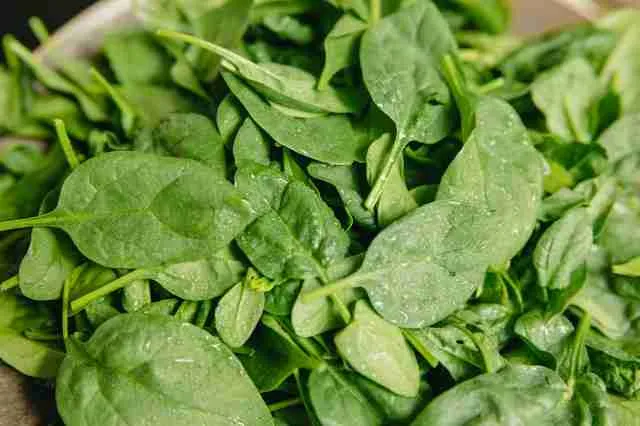
No, you shouldn’t serve frozen spinach to your cavies. Frozen spinach can harm the stomach of guinea pigs and it is also difficult to chew and digest.
You can only feed frozen spinach to your cavies once it is left to defrost at normal room temperature. Once the ice melts, remove extra water before serving it to the guinea pigs.
Final Thoughts
Cutting the long story short, guinea pigs can eat spinach. Spinach has many health benefits for guinea pigs if it is served in the right amount.
Preferably, you should serve one or two chopped spinach leaves to your guinea pigs once or twice a week.
Avoid feeding spinach stalks and stems to your cavies as they can choke them.
Try feeding spinach to your tiny pets and see if they enjoy eating it or not.
Good luck!
Love It? Save It On Your Pinterest “Guinea Pig Board”!
